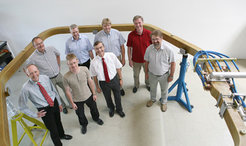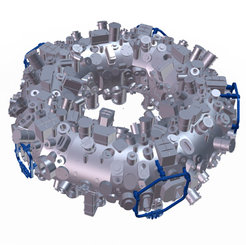First coil delivered from USA
USA participates in Wendelstein 7-X / million dollar investment in German fusion project

“I am very relieved that the coil has survived the 7,000-kilometre journey from Pennsylvania without damage”, said Konrad Risse, who is responsible for the auxiliary coils in the Wendelstein 7-X project. “The next step will be to measure the coil and to mark the points at which the supports that fix each coil to the outer vessel will be attached. Then five intermediate steel wedges must be inserted so that the coil supports fit perfectly against the vessel’s outline. Finally, the overhead crane will lift the coil in a specially designed supporting frame for installation in front of the vessel wall.” The coils will be attached one after the other from September onwards.

The five shop window-size coils on the outer shell of the plant are supposed to help with precise adjustment of the magnetic fields on the plasma edge. They ensure that the outer contour of the plasma maintains exactly the shape desired during later experiments. The basic data for the components came from the IPP; engineers and scientists from Princeton took over the construction and supervised industrial production. The 4.3 million dollar investment is the largest contribution to the USA’s scientific cooperation on Wendelstein 7-X. Overall, the USA is investing more than 7.5 million dollars in construction of the plant.
In return, the participating U.S. institutions become partners in the research programme of Wendelstein 7-X. In addition to the fusion laboratory at Princeton, the institutes in Oak Ridge and Los Alamos are also contributing to equipping the German research plant by planning parts of the wall covering and by supplying measuring instruments for observation of the plasma. This German-American cooperation is one of a total of nine projects under the U.S. Department of Energy’s “Innovative Approaches to Fusion” programme.
Isabella Milch

